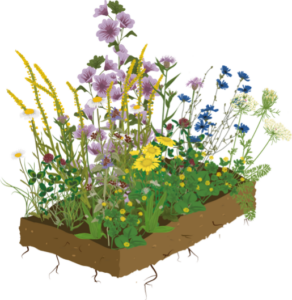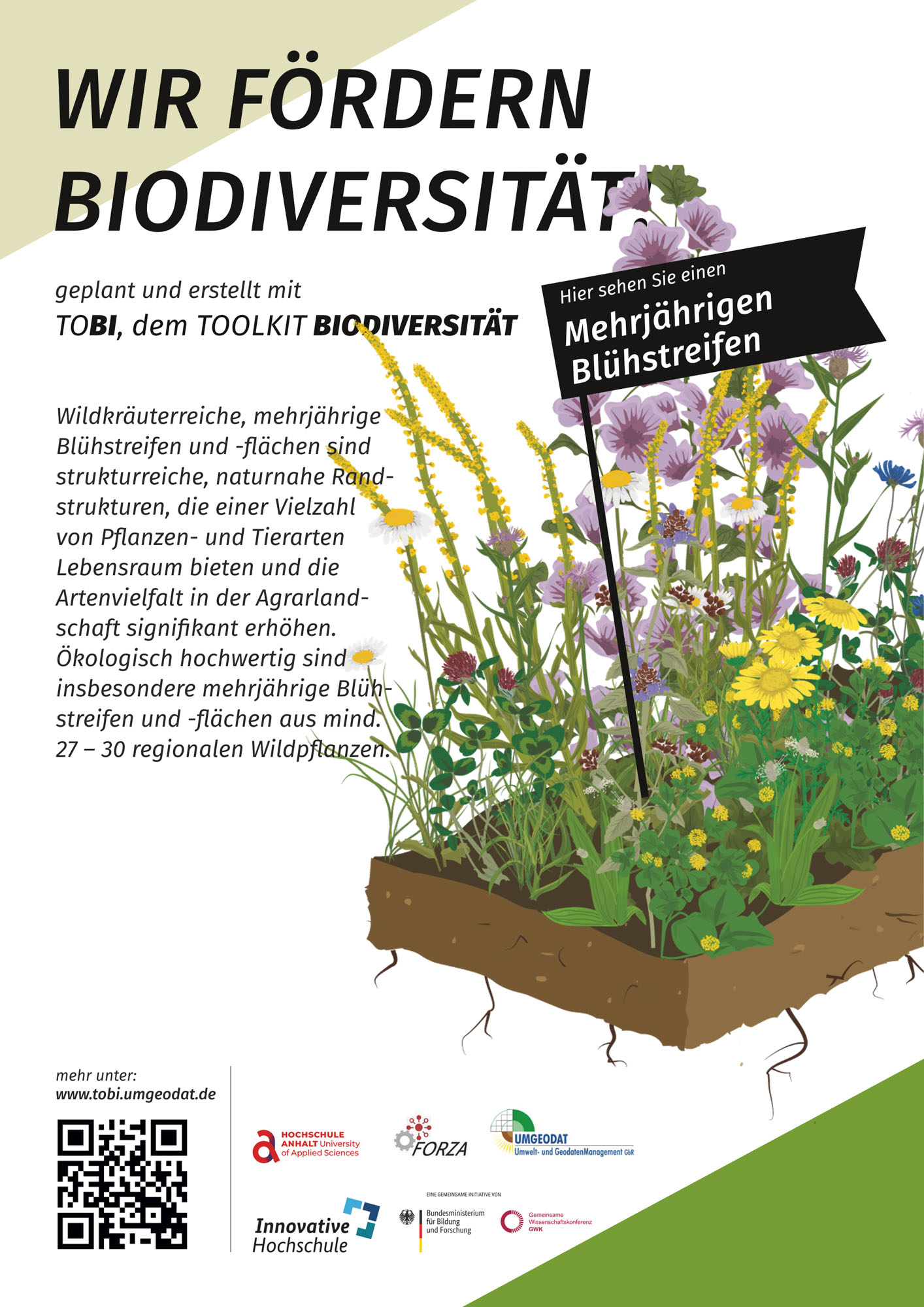Find out all about perennial flower strips
Sind Sie sicher ob der Standort geeignet ist?
Das Profitool erkennt Flächen und kann die optimale Nutzung bestimmen. PROFITOOL
Besonders effektiv in Kombination mit
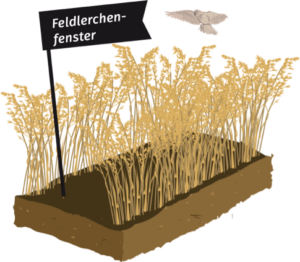
Do you need support?
Then please contact us by phone 039209 / 202076 or by e-mail at info@stiftung-kulturlandschaft-sachsen-anhalt.de.
Requirements
Strip width and length
linear & flat, min. 5 x 10 m, 2 x as long as wide
Site and soil conditions:
- dry to normal
- preferably sunny
Costs, seed costs:
seed costs approx. 450-500€ /ha (netto), 300-500€/ha plus soil cultivation
Machinery requirements:
- Cultivator
- rotary tiller
- Drilling machine
- Mower
- Grinder or chopper
Implementation period:
mid august - end of september
(Alternatively February-April, but risk of spring drought and poor establishment)
Implementation
step-by-step instruction
1. Site selection
Suitable locations are:
- in the open fields
- along sunny sides of hedges, rows of trees, forest edges
- near sand paths, old gravel pits, steep walls
- on marginal land (good development potential!)
- the wider/larger the strip or area, the more effective the measure
Less suitable locations are:
- with problematic weeds such as couch grass, creeping thistle, etc. - these sites need a particularly good soil preparation
- sites with prior grass sowing (->only after particularly good soil cultivation!)
- sites that are heavily shaded (->create wide strips along copses)
Not suitable locations:
- that are permanently wet
- which are regularly driven on (e.g. water maintenance)
- on busy roads (wild animal accidents!)
Size:
- at least 5 x 10 m wide, must be 2 x as long as wide
- linear & flat up to 20 % of the acreage
- The wider the strip, the more effective the measure (fewer chances for predators)
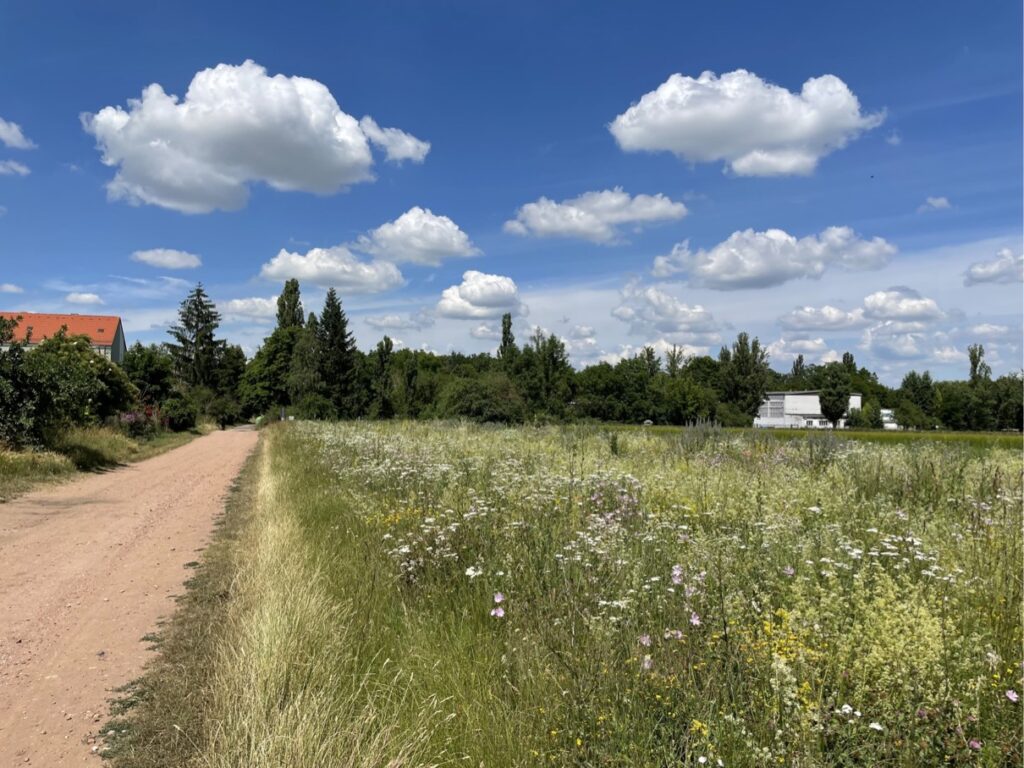
Sowing date
Late summer/autumn sowing:
- from August to mid-September (depending on the weather, by the beginning of October at the latest)
- to be favoured in regions with spring drought
Spring sowing:
- as soon as the weather permits sowing: February/March until the end of April at the latest
- in regions with severe spring drought, if possible until mid-April
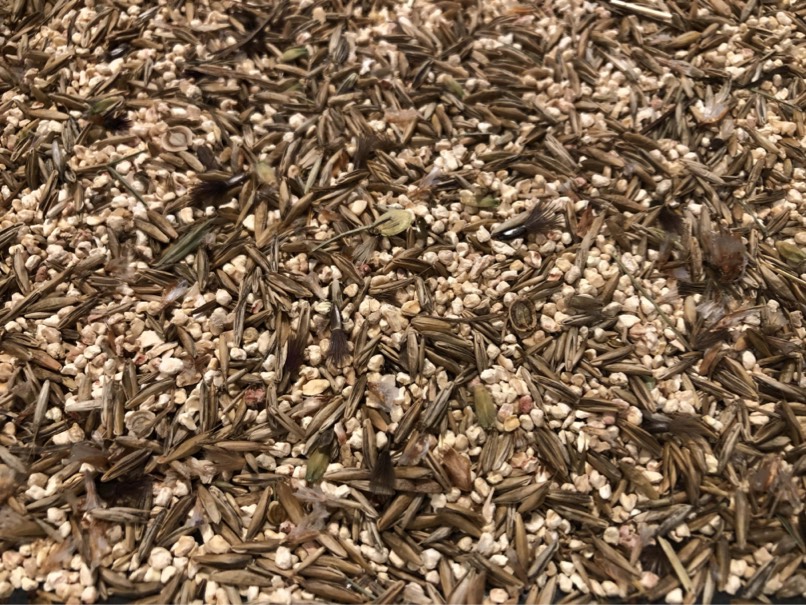
Seed selection
Exclusive use of native, certified wild herbs (VWW-Regiosaaten®, RegioZert®) with 27-30 herbs per mixture
Map of the regions of origin (grasses and herbs) in Germany
More information about wild plant seeds (in German), VWW
Saxony-Anhalt
Saxony-Anhalt: 5 predetermined mixtures (depending on site conditions):
Saxony-Anhalt is located in the areas of origin ‘4 - East German lowlands’ and ‘5 - Central German lowlands and hills’. The seed used should originate from these regions.
The five seed mixtures are included in the MSL Merkblatt and in the brochure ‘Hinweise zur erfolgreichen Anlage und Pflege mehrjähriger Blühstreifen und Blühflächen mit gebietseigenen Wildarten’ (Fenchel et al. 2015):
Seed ordering
- Place your order as soon as possible (long delivery times possible)
- Seed quantity approx. 4 – 5,2 kg/ha (depending on mixture)
- Mixing with filler (soya meal or crushed maize) to approx. 50 - 100 kg/ha (total application rate, can be ordered ready-mixed from the companies) -> to avoid segregation, for even application
Seed costs approx. 450 € – 500 €/ha
Sources of supply for certified regional wild plant seeds in Germany:
VWW-Regiosaatgut über Verband deutscher Wildsamen- und Wildpflanzenproduzenten e.V.
RegioZert über Bundesverband Deutscher Pflanzenzüchter e. V.

Seedbed preparation
Thorough tillage (stubble cultivation, tilling, cultivating) to produce a fine-crumb seedbed for fine seed sowing (such as arable forage sowing or grassland) must be carried out in preparation.
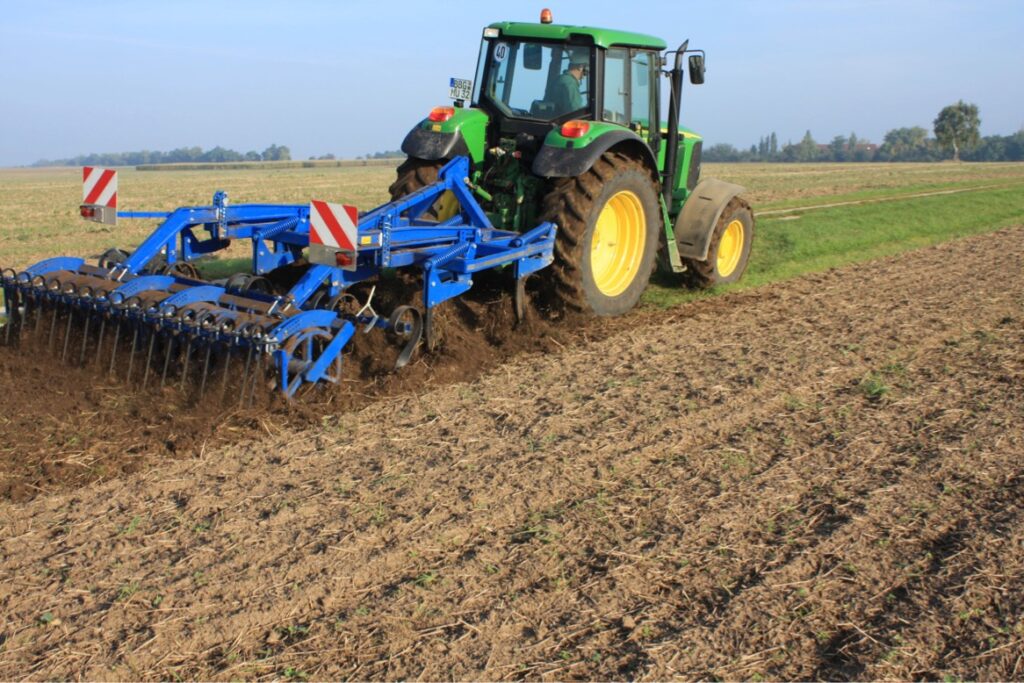
Sowing
Crucial for successful sowing:
- Sow seeds on the surface (light germinators)
- Do NOT drill in but only ‘trickle on’ -> the light-coloured pieces of the filler must be visible on top of the soil
- Harrow + seed coulters up!
The seed must NOT be worked into the soil like other crops. Very shallow sowing on the soil surface is necessary due to the many light germinators.
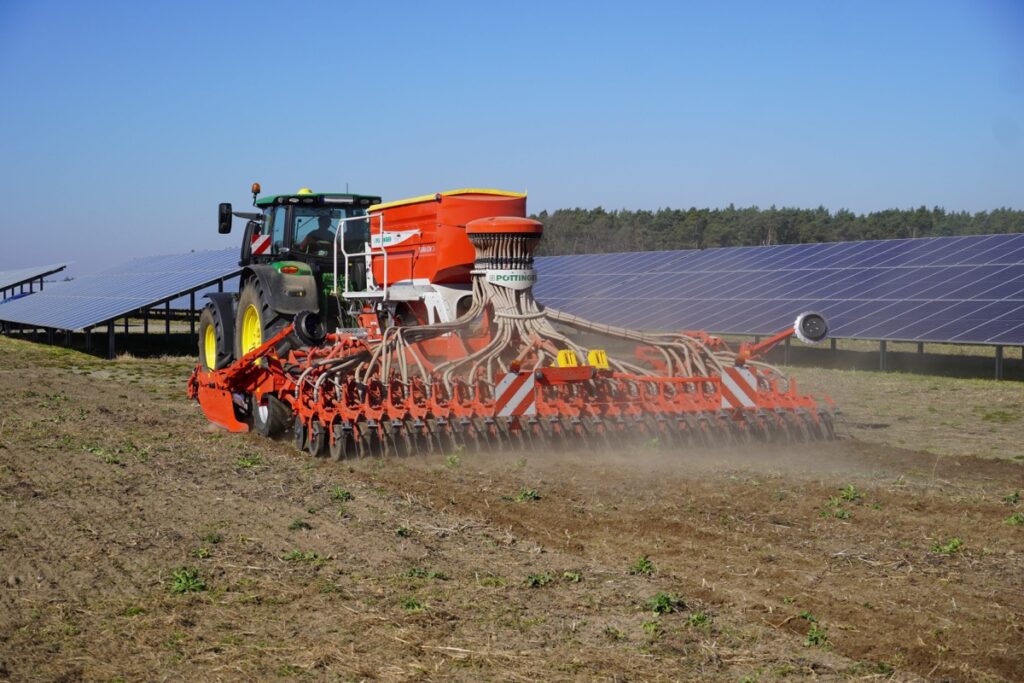
Rolling
Rolling is important for good contact of the seeds to the soil, which they need to germinate successfully.
Patience! Patience! Patience!
- The germination of wild plants is inconsistent and sometimes very delayed.
- Many wild plants grow more slowly than cultivated species in the first few months and initially look like unwanted weeds.
Give the wild plants time to develop and preferably come back in spring or 3 - 4 months after sowing!
additional information::
Wild plant seedlings develop differently to agricultural crops: the germination of wild plants is much more inconsistent and in some cases very delayed. The germination protection of some species must be broken by cold or prolonged moisture. Not all seeds germinate at once, which serves to spread the risk and prevent total failure, e.g. due to drought shortly after germination. Many wild plants grow more slowly in the first few months than cultivated species. Therefore, please be patient after sowing.
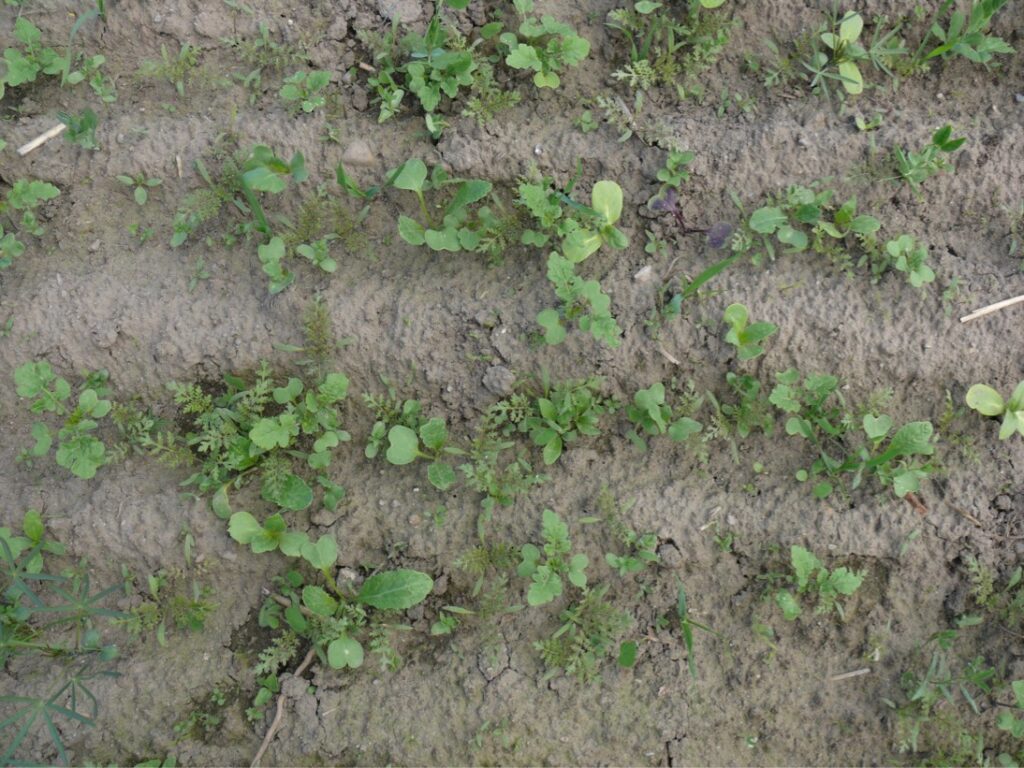
Care
step-by-step instruction
General care instructions
The general rule is:
- as little as possible, but as much as necessary
- Care is not mandatory, but is highly recommended in most cases
In addition to the recommendations (e.g. times, area proportions), there are also specifications for maintenance (e.g. maximum 70% of the area at one maintenance time, closed period between 1 April and 30 June).

Development maintenance in the 1st year
Hohes Abschlegeln (Richtwert 20 cm) zur
- Extension of the flowering period (rapid resprouting of the species when maintained from the beginning to approx. the end of July)
- Reduction of problematic species
- Reduction of biomass
Note: CAN, not MUST
When?
- with heavy weed pressure (e.g. dense stands of camomile, broomrape, white goosefoot, amaranth)
- when the plants are about knee-high
- for autumn sowings, possibly still in the same year
Hinweise zu mehrjährigen Blühstreifen mit gebietseigenen Wildpflanzen (S. Mann, 2020)
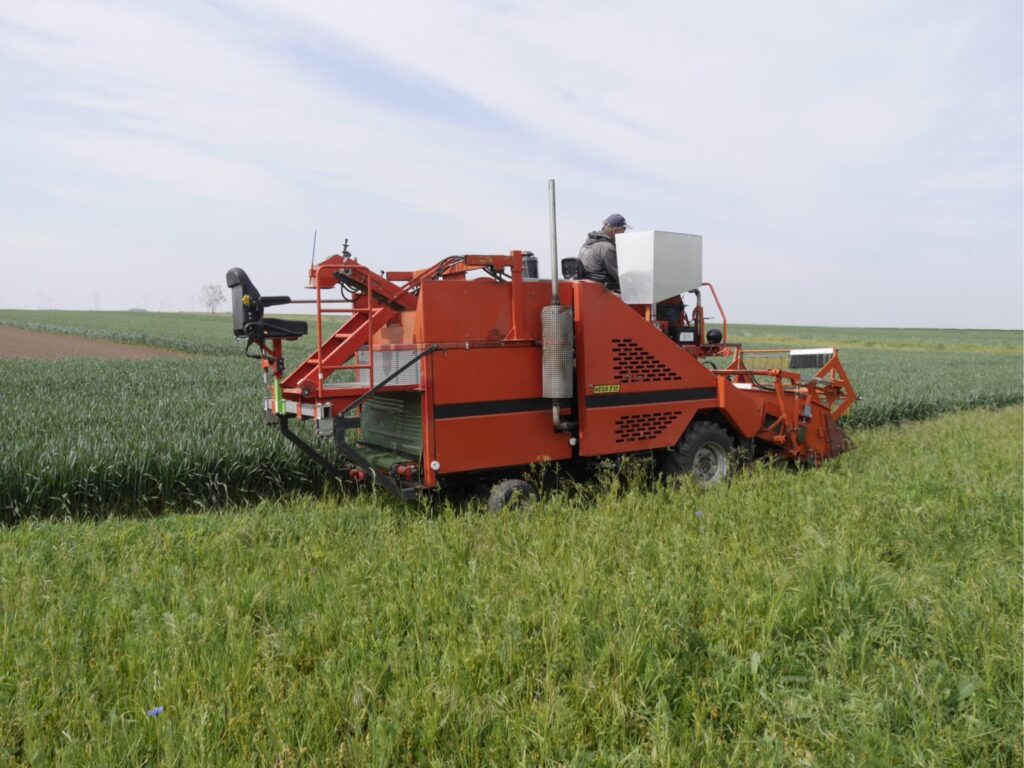
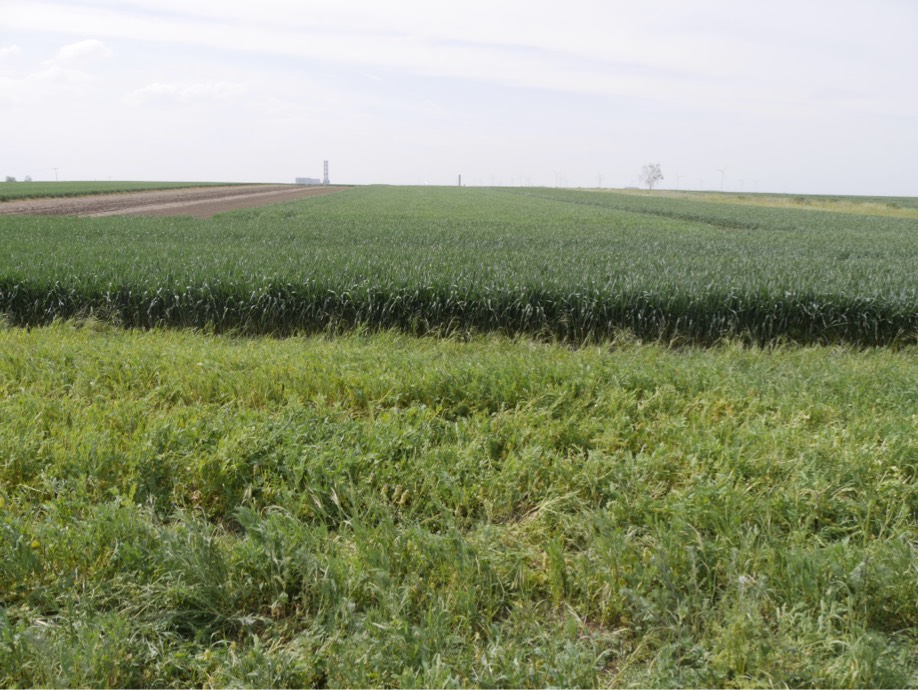
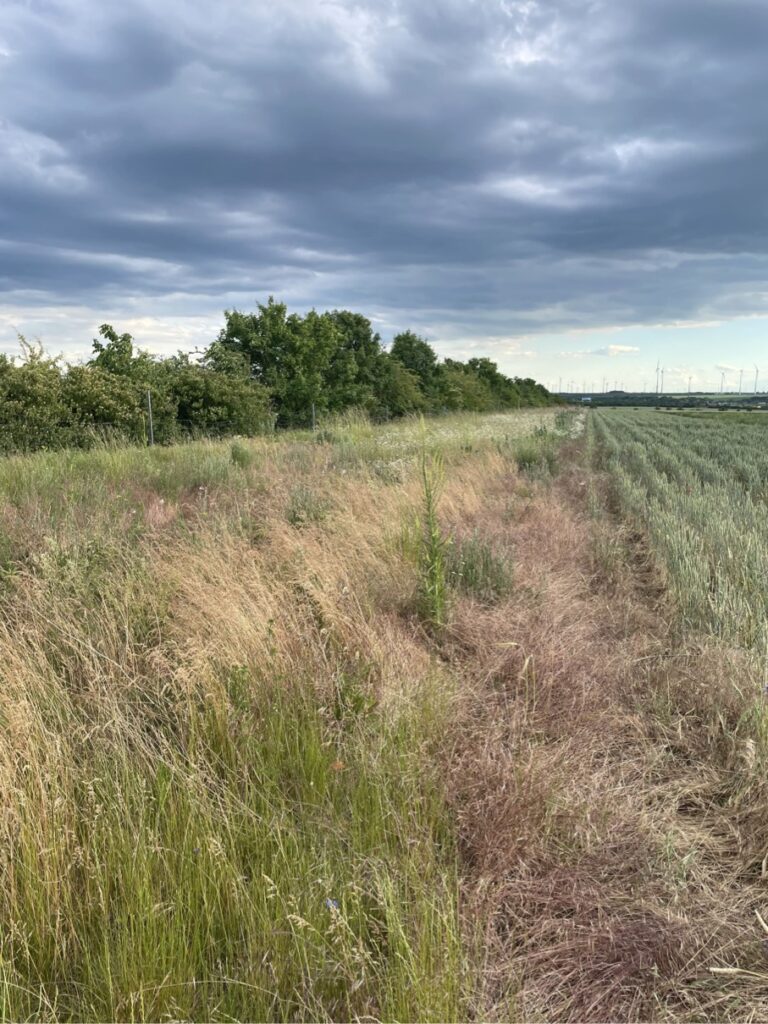
Closed season and Application for exemption
Closed season
During the breeding and setting season from 1 April to 30 June, maintenance mowing is only possible with special excemption (ALFF / UNB). The reason for this would be, for example, the high incidence of problem species (Section 5 (4) of the Agrar- ZahlVerpflV). Outside of this closed season, mowing is permitted without an application.
Application for excemption for maintenance mowing
I/We hereby apply for approval of a maintenance cut in the period from 1 April to 30 June 2021 for the measure applied for by me/us to promote the integration of natural structural elements in the field in order to counteract the risk of newly sown or existing structural elements being suppressed by emerging weeds and thus jeopardising the success of the support measure for the fields listed below.
Muster-/Beispielantrag für einen „Ausnahmeantrag für einen Pflegeschnitt“ (Stand 2021)
Further information, FAQs and news for Saxony-Anhalt in the ELAISA-Portal
Maintenance and handling of the mown material
- Maintenance cutting should preferably be carried out on partial areas in order to maintain areas of retreat.
- Cuttings must not be used and can remain on the area
- A high setting of the equipment (grinders or choppers) is necessary to avoid damaging the young plants.
In addition to the recommendations (e.g. times, area proportions), there are also specifications for maintenance (e.g. maximum 70% of the area at one maintenance time, closed period between 1 April and 30 June).
Hinweise zur Einschätzung der Entwicklung & richtigen Pflege mehrjähriger Blühstreifen & Blühflächen (S. Mann, 2021)
Hinweise zu mehrjährigen Blühstreifen mit gebietseigenen Wildpflanzen (S. Mann, 2020)
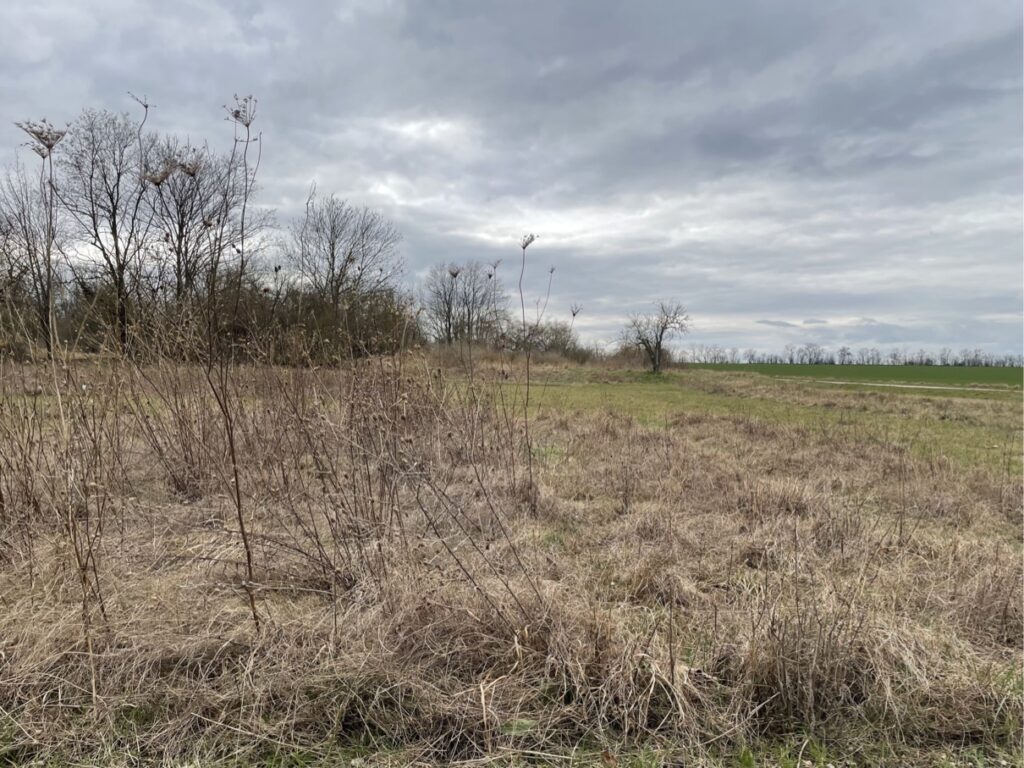
Maintenance care from the 2nd year onwards
High flailing (guideline 20 cm) to protect the sown young plants in early-mid July on partial areas (especially on low-yielding sites)
- Maintenance mowing of 30 - 50 % of the area recommended, max. 70 % per area at the time of maintenance
The preservation of overgrown stands provides food, cover and egg-laying opportunities for mammals, birds and insects.
- Cuttings must not be used and can remain on the area
Caution:
Here, too, the closed period applies from 1 April to 30 June. If there are problems in the area, an exemption permit for maintenance cutting during the closed period can be applied for from the responsible ALFF (see step 3).
Ecological impact
Wild herb-rich, perennial flower strips/areas promote biodiversity in the agricultural landscape. They provide important breeding and feeding habitats as well as refuges for many plant and animal species in the cultivated landscape. Perennial flower strips and areas made from certified, local seed mixtures are of particularly high ecological value. This measure is also well suited to dividing large, uniformly managed fields and thus increasing the ecological continuity of the areas.
A proportion of flower strips of 6-10 % of arable land is suitable for achieving a significant increase in the number of species and territories of typical farmland birds, especially when planted in open landscapes. Sandy paths, old gravel pits and steep walls serve as nesting habitats for wild bees, among others, so that the establishment of flower strips near these is an ideal food source for wild bees. The use of regional mixtures of wild herbs provides a wide range of food for various groups of insects, including wild bees, butterflies and hoverflies.
Depending on the mixture and the wild plant species used, up to 50 different native insect species can benefit from the measure. The common hornwort (Lotus corniculatus), for example, is used as a food source by at least 36 butterfly species, 13 highly specialised and 44 other wild bee species, the meadow widow flower (Knautia arvensis) by up to 44 butterfly species and at least 16 different wild bee species and the common sheep's milkwort (Achillea millefolium) by up to 51 butterfly species and over 20 wild bee species.
Additional information (mostly in German)
Hinweise zur erfolgreichen Anlage und Pflege mehrjähriger Blühstreifen und Blühflächen mit gebietseigenen Wildarten – Maßnahmen zur Erhöhung der Biodiversität in Sachsen- Anhalt (Fenchel et al. 2015)
Präsentation zu mehrjährigen Blühstreifen mit gebietseigenen Wildpflanzen (Mann 2020):
Erfolgreiche Anlage mehrjähriger Blühstreifen auf produktiven Standorten durch Ansaat wildkräuterreicher Samenmischungen und standortangepasste Pflege (Kirmer et al. 2016)
Artenvielfalt und Biodiversität stärken im Ackerbau. DLG-Merkblatt 431 (DLG e.V. (Hrsg.) 2018)
Merkblatt zu mehrjährigen Blühstreifen/-flächen https://www.offenlandinfo.de/fileadmin/user_upload/Betriebsplan_Biodiversitaet/01_Mehrj_Bluehstreifen.pdf
Informationen zur Biodiversitätsförderung in der Agrarlandschaft (Säume, Feldraine und Blühstreifen) der Hochschule Anhalt
Video: Evaluierung mehrjähriger Wildpflanzenblühstreifen (Hochschule Anhalt 2021)
Effects of wildflower strips, landscape structure and agricultural practices on wild bee assemblages – A matter of data resolution and spatial scale? (Hellwig et al. 2022)
Effects of perennial wildflower strips and landscape structure on birds in intensively farmed agricultural landscapes (Schmidt et al. 2022)
Habitat quality and surrounding landscape structures influence wild bee occurrence in perennial wildflower strips (Schubert et al. 2022)
Ansaaten mit heimischen Wildpflanzen erhöhen die Biodiversität in Agrarlandschaften: Praxisversuche zur Anlage artenreicher Feldraine und mehrjähriger Blühstreifen in Sachsen-Anhalt (Kirmer et al. 2021)
Evaluating CAP wildflower strips: High-quality seed mixtures significantly improve plant diversity and related pollen and nectar resources (Schmidt et al. 2021)
Seed mixture strongly affects species-richness and quality of perennial flower strips on fertile soil (Schmidt et al. 2020)
